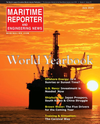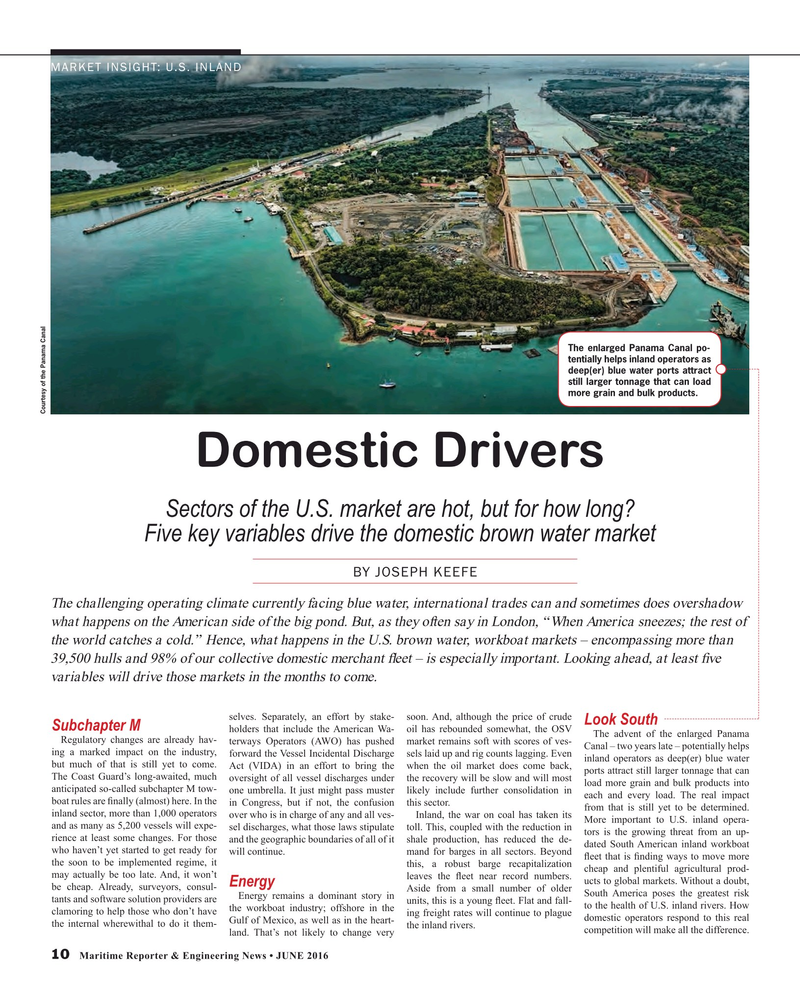
Page 10: of Maritime Reporter Magazine (June 2016)
Annual World Yearbook
Read this page in Pdf, Flash or Html5 edition of June 2016 Maritime Reporter Magazine
MARKET INSIGHT: U.S. INLAND
The enlarged Panama Canal po- tentially helps inland operators as deep(er) blue water ports attract still larger tonnage that can load more grain and bulk products.
Courtesy of the Panama Canal
Domestic Drivers
Sectors of the U.S. market are hot, but for how long?
Five key variables drive the domestic brown water market
BY JOSEPH KEEFE
The challenging operating climate currently facing blue water, international trades can and sometimes does overshadow what happens on the American side of the big pond. But, as they often say in London, “When America sneezes; the rest of the world catches a cold.” Hence, what happens in the U.S. brown water, workboat markets – encompassing more than 39,500 hulls and 98% of our collective domestic merchant ? eet – is especially important. Looking ahead, at least ? ve variables will drive those markets in the months to come.
selves. Separately, an effort by stake- soon. And, although the price of crude
Look South
Subchapter M holders that include the American Wa- oil has rebounded somewhat, the OSV
The advent of the enlarged Panama
Regulatory changes are already hav- terways Operators (AWO) has pushed market remains soft with scores of ves-
Canal – two years late – potentially helps ing a marked impact on the industry, forward the Vessel Incidental Discharge sels laid up and rig counts lagging. Even inland operators as deep(er) blue water but much of that is still yet to come. Act (VIDA) in an effort to bring the when the oil market does come back, ports attract still larger tonnage that can
The Coast Guard’s long-awaited, much oversight of all vessel discharges under the recovery will be slow and will most anticipated so-called subchapter M tow- one umbrella. It just might pass muster likely include further consolidation in load more grain and bulk products into each and every load. The real impact boat rules are ? nally (almost) here. In the in Congress, but if not, the confusion this sector.
from that is still yet to be determined. inland sector, more than 1,000 operators over who is in charge of any and all ves-
Inland, the war on coal has taken its More important to U.S. inland opera- and as many as 5,200 vessels will expe- sel discharges, what those laws stipulate toll. This, coupled with the reduction in tors is the growing threat from an up- rience at least some changes. For those and the geographic boundaries of all of it shale production, has reduced the de- dated South American inland workboat who haven’t yet started to get ready for will continue. mand for barges in all sectors. Beyond ? eet that is ? nding ways to move more the soon to be implemented regime, it this, a robust barge recapitalization cheap and plentiful agricultural prod- may actually be too late. And, it won’t leaves the ? eet near record numbers. ucts to global markets. Without a doubt,
Energy be cheap. Already, surveyors, consul-
Aside from a small number of older South America poses the greatest risk
Energy remains a dominant story in units, this is a young ? eet. Flat and fall- tants and software solution providers are to the health of U.S. inland rivers. How clamoring to help those who don’t have the workboat industry; offshore in the ing freight rates will continue to plague domestic operators respond to this real
Gulf of Mexico, as well as in the heart- the internal wherewithal to do it them- the inland rivers. competition will make all the difference. land. That’s not likely to change very 10 Maritime Reporter & Engineering News • JUNE 2016
MR #6 (10-17).indd 10 6/7/2016 9:30:16 AM

 9
9

 11
11
